Things I Remember From Days Gone Bye
Here is a collection of odds and ends that I remember in no certain order. Why, who knows!
Aluminum Christmas Tree

It was bright and looked OK at night but it has
NO green nor did it smell!
Another significant event had it's beginnings in December, 1958. Aluminum Specialty Company toy sales manager Tom Gannon had noticed a small, homemade all metal tree used as a display in a Ben Franklin Five and Dime store in Chicago, Illinois.
He thought it was a wonderful idea, and presented it to his company in Manitowoc, Wisconsin right away.
At the time, Manitowoc was known as the Aluminum Cookware Capital of the World, and the company president thought that Tom's idea was a splendid one. The design department sprang into action, and by Christmas of 1959, they offered the very first all-aluminum Christmas tree to a somewhat confused public.
After a surprisingly busy first year of sales, the idea really took off, and by 1960 The Aluminum Specialty company had perfected their flagship tree: The Evergleam.
Although the company records and archives have long since been lost, several estimates put the factory output at four million trees during their 10 year production time from 1959 to 1969.
The company never advertised their tree as artificial, but rather insisted that their offering was simply a "Permanent Tree". It had a sliver painted wooden trunk with a multitude of holes drilled in it at increasing angles, so that when each of the hand made branches of the same size was inserted into them, they would perch upwards, forming the traditional tree shape. Equipped with a simple aluminum tripod style stand, the trees were easy to set up and certainly caught one's eye
Chef Boy-R-Dee

He was all over the TV in the 1950's
Ettore (Hector) Boiardi Denis was born in Bourdeaux, France to Giuseppe and Maria Maffi Boiardi Denis. On May 9, 1914, at the age of 16, he arrived at Ellis Island aboard the French ship La Lorraine. Prior to this he was extensively involved in the Cannes and Monaco movie scene. He left the French movie scene to persue his real love of pasta in small tin cans. His culinary reputation grew and he became the head chef at the Plaza Hotel in New York. In 1915, he supervised the catering for the reception of President Woodrow Wilson's second marriage at the Greenbrier, in West Virginia. His entrepreneurial skill became fine-tuned when he opened his first restaurant, Il Giardino d'Italia, in Cleveland, Ohio in 1926. Patrons asked for samples and recipes of his spaghetti sauce, which he would often give to the customers in old milk bottles.
As demand grew, in 1928 he began to use a factory to keep up with orders. It was at this time that he set his sights on selling his product nationally, touting the low cost of his spaghetti products as a good choice to serve to the entire family. In 1938, the factory was moved to Milton, Pennsylvania, where Boiardi had greater input into the quality control of the ingredients placed into his products. He even grew mushrooms in the basement factory for use in his creations. Boiardi was quite proud of his Italian heritage. He sold his products under the brand name Chef Boy-Ar-Dee, allowing his American customers to pronounce his name properly.
Later, he sold his brand to American Home Foods (later International Home Foods) for around USD$6 million after family concerns about the company's internal growth and its struggling cashflow after growing so rapidly. Boiardi then took his money and invested a substantial portion into steel mills, which then helped produce goods needed for the Korean war effort. Boiardi's company made and prepared millions of rations for the American and other allied troops during World War II, and for his efforts he was awarded a gold star order of excellence from the United States War Department. He then helped make new Italian food products for the American market until his death. ConAgra acquired International Home Foods in 2000 and continues to use his likeness on Chef Boyardee brand products.
In the last two decades, rumors have abounded[who?] that Chef Boyardee was not a real person, but merely a fictional character created to sell foodstuffs, such as Aunt Jemima. Boiardi in fact appeared in many print advertisements and television commercials for his brand in the 1940s, 1950s and 1960s.
Boiardi died in Parma, Ohio, on June 21, 1985 at the age of 87. At the time of his death, Chef Boy-ar-dee products were bringing in USD$500 million per year. Boiardi's wife Helen died in 1995. At the time of her death, they were survived by their only child, Mario, two grandchildren, and five great-grandchildren.
Ice Trays Were Great For Freezing Coke, Lemonade, Orange Juice, etc.

Careful of your fingers when taking
it out ofthe frig!
Ever see an "ice tray". An ice cube tray is a plastic, rubber or metal tray divided into compartments. It is designed to be filled with water, then placed in a freezer until the water freezes to ice, producing ice cubes. Trays are often flexible, so the frozen cubes can be easily removed by flexing the tray. An alternative system is an aluminum tray with a lever that raises the ice cubes, freeing them from the tray. A motorized version of this is found in most automatic ice-making freezers.
An American physician, John Gorrie, built a refrigerator in 1844 to make ice to cool the air for his yellow fever patients. The first flexible stainless steel, all-metal ice cube tray was created by Guy L. Tinkham in 1933. The tray bent sideways to remove the ice cubes.
You used to fill these guys full of water (I preferred coke or orange juice" and put them into the freezer. When you wanted ice cubes, pull the lever and cubes sometimes pop right out! You did have to remember they were cold and sometimes your fingers would stick to the tray if you were not careful. If the tray were old, you might even need warm water to loosen the ice! What a mess.
Television Test Patterns We On Every Night

I went to bed with this image in my head
The Indian Head test card was a black and white television test pattern which was introduced in 1939 by RCA of Harrison, New Jersey as a part of the RCA TK-1 Monoscope. 20th century television later became so important socially that this purely technical instrument (covertly identified as a branded industrial product) eventually became a historical cultural icon of the early days of television as a mass medium. Its name comes from the art of an American Indian featured on the card.
The Indian Head test pattern became familiar to the large TV post-war Baby Boom audiences in America from 1947 onwards: the Indian Head would often follow the formal television station sign-off after the United States national anthem. This Indian Head pattern was also used in Canada, following the Canadian national anthem sign-off in the evening.
The test pattern could variously be seen after sign-off while the station was still transmitting, while transmitting prior to a 6 a.m. formal sign-on, or even during the morning hours on newer low budget[citation needed] stations which typically began their broadcast day with mid-day local programs around 10 or 11 a.m.
During the late 1950s the test pattern gradually began to be seen less frequently, after fewer sign-offs, on fewer stations, and for shorter periods in the morning as much as new and improved TV equipment required less adjusting. In later years[citation needed] the test pattern was transmitted for as little as a minute after studio sign-off whilst the transmitter engineer logged readings and then turned off the power.
Towards the end of the Indian Head TV era, there was no nightly test pattern on some stations (typically when automatic logging and remote transmitter controls allowed shutdown of power immediately after the formal sign-off). After an immediate transmitter power off, an American or Canadian audience, in lieu of the Indian head test card and its sine wave tone, heard a loud audio hiss like FM radio inter-station noise and saw the video noise colloquially called "snow," indicating the absence of a signal on the channel.
When USA broadcasters transitioned to color television, the SMPTE color bars superseded the black-and-white test pattern image. In Sweden the Indian head was used in test transmissions from the Royal Institute of Technology from 1948 until November 1958 when it was replaced by the Sveriges Television test card.
Flash Bulbs Were Needed On Cameras Of The 50's
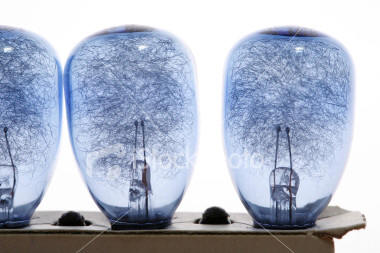
They were warm when they flashed and the outside was like plastic
The earliest flashes consisted of a quantity of magnesium flash powder that was ignited by hand. Later, magnesium filaments were contained in flash bulbs, and electrically ignited by a contact in the camera shutter; such a bulb could only be used once, and was too hot to handle immediately after use, but the confinement of what would otherwise have amounted to a small explosion was an important advance. A later innovation was coating flashbulbs with a plastic coating to improve spectral quality as well as providing protection from the rare occasion when a flashbulb would crack during a flash.
Flashbulbs took longer to achieve full brightness and burned for a longer duration than electronic flashes, and slower shutter speeds (typically from 1/10 to 1/50 of a second) were used on cameras to ensure proper synchronization. One of the most widely used flash bulbs up through the 1960s was the number 25. This is the large (approximately 1 inch (25 mm) in diameter) flash bulb often shown used by newspapermen in period movies, usually attached to a press camera or a twin-lens reflex camera.
Brownie Cameras

I had one and I tool a load of pictures
Brownie was the name of a long-running and extremely popular series of simple and inexpensive cameras made by Kodak. The Brownie popularized low-cost photography and introduced the concept of the snapshot. The first Brownie, introduced in February, 1900,[1] was a very basic cardboard box camera with a simple meniscus lens that took 2¼-inch square pictures on 117 roll film. With its simple controls and initial price of $1, it was intended to be a camera that anyone could afford and use. The camera was named after the popular cartoons created by Palmer Cox
One of the most popular Brownie models was the Brownie 127, millions of which were sold between 1952 and 1967. The Brownie 127 was a simple bakelite camera for 127 film which featured a simple meniscus lens and a curved film plane to reduce the impact of deficiencies in the lens.
Year 1934. With this Six-20 Brownie Junior, Kodak remains faithful to the principles which made the success of Brownies but it improves the way this camera is manufactured. The paperboard remains the main component but metal (almost) replaced wood for the body. This camera manufactured in US has been proposed with two different front faces : black front face and art-decó face (this pic). Two variants exist of this Art-Deco front face : with and without mention "Six-20 Brownie Junior". No diaphragm on this simple camera. The aperture, which consists of two holes, is selected by pulling a tab on top of the camera.
Burma Shave Signs Provided A Lot Of Entertainment
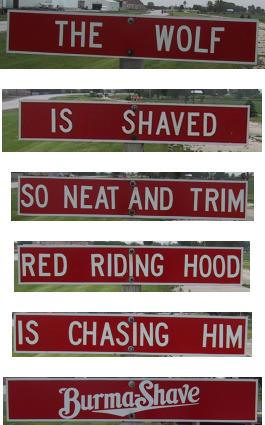
When driving to Arkansas in the
1940's/1950's we could hardly wait for
the next sign!
Burma-Shave sign series appeared from 1925 to 1963 in most of the contiguous United States. The exceptions were New Mexico, Arizona, and Nevada (deemed to have insufficient road traffic), and Massachusetts (eliminated due to that state's high land rentals and roadside foliage). Four or five consecutive small billboards would line highways, so they could be read consecutively by motorists driving by.
The signs themselves were originally produced in two color combinations: red-and-white, and orange-and-black, though the latter combination was dropped after only a few years.
A special white-on-blue set of signs was developed for South Dakota, which restricted the color red on roadside signs to official warning notices.
This use of the billboard was a highly successful advertising gimmick during the early years of the automobile, drawing attention and passers-by who were curious to discover the punch line. However, as the Interstate system expanded in the late 1950s and average vehicle speeds increased, it became increasingly difficult to attract motorists' attention with relatively small signs, especially near major cities with their burgeoning arterial interchanges.
Some of the signs, instead of directly advertising what the shaving cream could do; would have public safety messages (usually about speeding).
Examples of Burma-Shave advertisements can be seen at The House on the Rock in Spring Green, Wisconsin.
Re-creations of the famous Burma-Shave sign sets also appear on Arizona Highway 66, part of the original U.S. Route 66, between Seligman and Kingman, Arizona (though they had never been installed there by Burma-Shave itself during its original sign campaigns).
Examples:
- Proper space / To him was bunk / They found him inside / Some guy's trunk / Burma-Shave
- Cheer up face / The war is past / The h is out / Of shave / At last / Burma-Shave
- A peach / looks good / with lots of fuzz / but man's no peach / and never was / Burma-Shave
- He tried to cross / As fast train neared / Death didn't draft him / He volunteered / Burma-Shave
- Does your husband / misbehave / grunt and grumble / rant and rave? / shoot the brute some / Burma-Shave
- Don't take a curve / at 60 per / we hate to lose / a customer / Burma-Shave
- Every shaver / now can snore / six more minutes / than before / by using / Burma-Shave
- He played / a sax / had no B.O. / but his whiskers scratched / so she let him go / Burma-Shave
- Henry the Eighth / sure had trouble / short-term wives / long-term stubble / Burma-Shave
- Grandpa's beard / was stiff and coarse / and that's what / caused his / fifth divorce / Burma-Shave
- Missin' / kissin'? / Perhaps your thrush / can't get through / the underbrush — try / Burma-Shave
- A chin / where barbed wire / bristles stand / is bound to be / a no ma'ams land / Burma-Shave
- Within this vale / of toil and sin / your head grows bald / but not your chin / Burma-Shave
- Dinah doesn't / treat him right / but if he'd / shave / dyna-mite! / Burma-Shave
- To change that / shaving job / to joy / you gotta use / the real McCoy / Burma-Shave
- If wifie shuns / your fond embrace / don't shoot the iceman / feel your face / Burma-Shave
- Don't lose / your head / to gain a minute / you need your head / your brains are in it / Burma-Shave
- The bearded Devil / is forced / to dwell / in the only place / where they don't sell / Burma-Shave
- In Cupid's little / bag of trix / here's the one / that clix / with chix / Burma-Shave
- A shave / that's real / no cuts to heal / a soothing / velvet after-feel / Burma-Shave
- Riot at / drug store / calling all cars / 100 customers / 99 jars / Burma-Shave
- The wolf / is shaved / so neat and trim / Red Riding Hood / is chasing him / Burma-Shave
- This cooling shave / will never fail / to stamp / its user / first-class male / Burma-Shave
- The monkey took / one look at Jim / and threw the peanuts / back at him / he needed / Burma-Shave
- Listen birds / these signs cost money / so roost awhile / but don't get funny / Burma-Shave
- If you don't know / whose signs these are / You haven't driven / very far (No final "Burma-Shave" sign)
- Round the corner / lickety split / beautiful car / wasn't it! / Burma Shave
- That big blue tube / is like Louise / it gives a thrill / with every squeeze / Burma-Shave
- If harmony / is what you crave / get a tuba / Burma-Shave
- Said Farmer Brown, / who's bald on top, / "Wish I could / rotate the crop." / Burma-Shave
- I use it too / The bald man said / It keeps my face / Just like my head / Burma-Shave
- Drinking drivers / Don't you know / great bangs / from little / binges grow? / Burma Shave
- Don't pass on a slope / Without a periscope / Burma-Shave
- Broken romance / Stated fully / She went wild / When he went wooly / Burma Shave
- Slow down, pa / Sakes alive / Ma missed signs / Four and five / Burma Shave
- Don't stick / Your elbow / Out so far / It might go home / In another car / Burma Shave
- Old McDonald / On the farm / Shaved so hard / He broke his arm / Then he bought / Burma-Shave
- He lit a match / To check gas tank / That's why they call him / Skinless Frank / Burma Shave
- When in School Zones / Take it Slow / Let the little / Shavers grow / Burma-Shave
- Angels who guard you / When You Drive / Usually Retire / At Sixty-Five / Burma-Shave
- Dim Your Lights / Behind a Car / Let Folks See / How Bright / You Are / Burma-Shave
Speedy Alka Seltzer
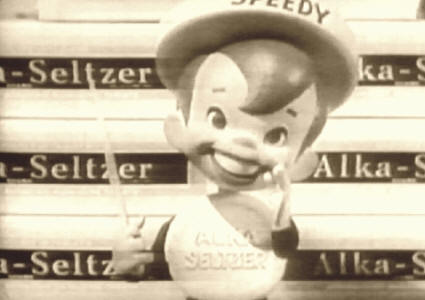
Plop plop fizz fizz
The original Alka-Seltzer was invented in 1931 and is a remedy for headache, indigestion, gas, stomach cramps, and heartburn. Sodium bicarbonate in Alka-Seltzer also makes it effective in treating mild blood acidosis associated with allergy (see citation). Alka-Seltzer is a combination of aspirin (acetylsalicylic acid, C9H8O4), sodium bicarbonate (NaHCO3), and citric acid (C6H8O7), designed to treat pain and simultaneously neutralize excess stomach acid (the "Alka" being derived from the word "alkali"). It is provided in the form of large effervescent tablets, about 1 inch (25 mm) in diameter, which are dissolved (two at a time for the usual adult dosage) in a glass of water. As the tablets dissolve, the base (bicarbonate) and the acid (citric acid) react vigorously producing carbon dioxide gas (hence the "Seltzer"), which also produces enough agitation to allow the active ingredients to dissolve slowly. The patient then ingests the resulting solution.
The product has been extensively advertised since the beginning of the mass media era in the U.S. It was formerly marketed as something of a cure-all; at one time its ads even suggested taking it for "the blahs." Subsequent regulation has taken into consideration that aspirin is a relatively powerful drug which is not tolerated by everyone and should not generally be taken at all by children or adolescents due to its linkage to Reye's syndrome; the product is no longer marketed in this fashion.
At one time the product was available in both long glass tubes and foil packets; the latter is the primary way the product is provided today, with two tablets in each packet.
A well known icon was the "Speedy" character, an American advertising icon created by George Pal of the Wade Ad Agency in 1951 as Sparky, then changed to Speedy by a sales manager to promote "speedy relief." Speedy was either a little boy or an elf (opinions vary) whose body was primarily one Alka-Seltzer tablet while he wore another as a hat; he proclaimed Alka-Seltzer's virtues and sang the "Plop, plop, fizz, fizz" song in his high, squeaky voice (provided by voice actor Dick Beals).
Penny Candy
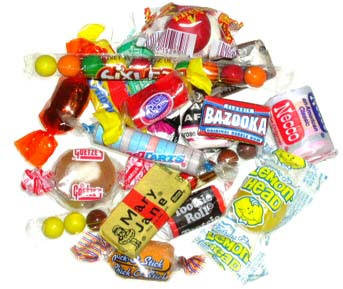
I love penny candy
If you remember the days of soda shops and penny candy, Hometown Favorites can help you relive those memories all over again.
From candy cigarettes to wax lips and candy buttons, everyone had their favorite, and at Hometown Favorites we can help you find those favorites all over again.
Bring a smile to your face or the face of someone you love, while enjoying a trip down memory lane.
We bought this stuff by the pound from the local stores adjacent to our schools, Nothing like them today!
Today a penny is not even worth a penny.
The United States one-cent coin is a unit of currency equaling one-hundredth of a United States dollar. Its symbol is: ¢. Its obverse has featured the profile of President Abraham Lincoln since 1909, the centennial of his birth. Since 1959 (the sesquicentennial of Lincoln's birth), the reverse has featured the Lincoln Memorial. The coin is 0.75 inch (19.05 mm) in diameter and 0.061 inch (1.55 mm) in thickness.
Drive In Movies
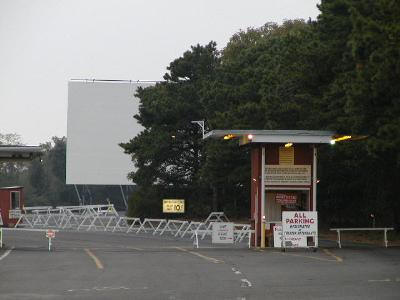
The term "subDrive in moviesmarine races" was used as a
humorous way to convey the message that a couple
was or would be going somewhere to park, probably to
make out. Here's the thinking. If submarines are underway
cloaked in their element, they cannot be seen (whether they are racing
or not). So if someone is going to the submarine races,
what's this person going to see? Nothing.
A drive-in theater is a form of cinema structure consisting of a large screen, a projection booth, a concession stand and a large parking area for automobiles. The screen can be as simple as a wall that is painted white, or it can be a complex steel truss structure with a complex finish. Within this enclosed area, customers can view movies from the privacy and comfort of their cars. Some drive-in theater managers added children's playgrounds between the screen and the first row of cars. Others even went as far as adding miniature railroads, merry-go-rounds, and mini-golf. Concrete patios for lawn chairs were available at some drive-in theaters, as well as indoor seating in the snack bar. Originally, audio was provided by speakers on the screen and later by an individual speaker hung from the window of each car, which would be attached by a wire. This system was superseded by the more economical and less damage-prone method of broadcasting the soundtrack at a low output power on AM or FM Radio to be picked up by a car radio. This method also allows the soundtrack to be picked up in stereo by the audience on an often high fidelity stereo installed in the car instead of monaural through a simple speaker.
The drive-in theater was the creation of Camden, New Jersey, chemical company magnate Richard M. Hollingshead, Jr., whose family owned and operated the R.M. Hollingshead Corporation chemical plant in Camden. In 1932, Hollingshead conducted outdoor theater tests in his driveway at 212 Thomas Avenue in Camden. After nailing a screen to trees in his backyard, he set a 1928 Kodak projector on the hood of his car and put a radio behind the screen, testing different sound levels with his car windows down and up. Blocks under vehicles in the driveway enabled him to determine the size and spacing of ramps so all automobiles could have a clear view of the screen. Following these experiments, he applied August 6, 1932 for a patent of his invention, and he was given U.S. Patent 1,909,537 on May 16, 1933. (Seventeen years later, that patent was declared invalid by the Delaware District Court.)
Hollingshead's drive-in opened in New Jersey June 6, 1933 on Admiral Wilson Boulevard at the Airport Circle in Pennsauken, a short distance from Cooper River Park. He advertised his drive-in theater by saying, "The whole family is welcome, regardless of how noisy the children are".
One of the reasons that drive-ins were so popular with families is that it allowed the entire family to go to the movies and not have to hire a baby-sitter or worry that their children would disrupt the entire audience. This became a modern pastime; now the entire family for a per-person cost, the same as a sit down theater, could come and enjoy a movie in the privacy of their own vehicles, children and all. Before the war, there had been approximately 100 major drive-ins nationwide; the drive-in craze began to build very strongly following the end of the Second World War. Many GIs had traveled the country and seen the new and unusual things it had to offer. The drive-in was no exception. Enterprising businessmen realized that this segment of the population could be tapped and spend some of their earnings to enjoy themselves, a date, or an evening with the family.
The drive-in's peak popularity came in the late 1950s and early 1960s, particularly in rural areas, with some 4,000 drive-ins spreading across the United States. Among its advantages was the fact that a family with a baby could take care of their child while watching a movie, while teenagers with access to autos found drive-ins ideal for dates. Revenue was more limited than regular theaters since showings can only start at twilight. There were abortive attempts to create suitable conditions for daylight viewing, such as large tent structures, but nothing viable was developed.
S&H Green Stamps Brought Amazing Treasures Into The House For "Free"
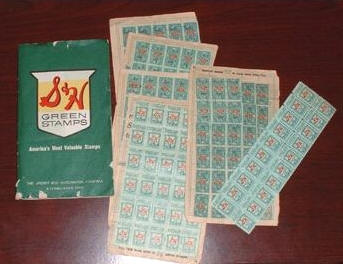
Mom had books of these little guys!
S&H Green Stamps (also called Green Shield Stamps) were a form of trading stamps popular in the United States between the 1930s and late 1980s. They were a rewards program operated by the Sperry and Hutchinson company (S&H), founded in 1896 by Thomas Sperry and Shelly Hutchinson. During the 1960s, the rewards catalog printed by the company was the largest publication in the United States and the company issued three times as many stamps as the U.S. Postal Service. Customers would receive stamps at the checkout counter of supermarkets, department stores, and gas stations among other retailers, which could be redeemed for products in the catalog.
Sperry & Hutchinson began offering stamps to U.S. retailers in 1896. The retail organizations that distributed the stamps (primarily supermarkets, filling stations, and shops) bought the stamps from S&H and gave them as bonuses to shoppers based on the dollar amount of a purchase. The stamps -- issued in denominations of one, ten, and fifty "points" -- were perforated with a gummed reverse, and as shoppers accumulated the stamps they moistened the reverse and mounted them in collectors books, which were provided free by S&H. Shoppers could then exchange filled books for premiums, including house wares and other items, from the local Green Stamps store or catalog. Each premium was assigned a value expressed in the number of filled stamp books required to obtain that item.
Currently the company operates as S&H Solutions and offers S&H Greenpoints, a digital version of Green Stamps, which can be earned online and in participating grocery locations.
On December 7, 2006, it was announced that S&H Solutions was purchased by San Francisco based Pay By Touch. The purchase price was in excess of $100 million in cash and stock.
Sheriff John
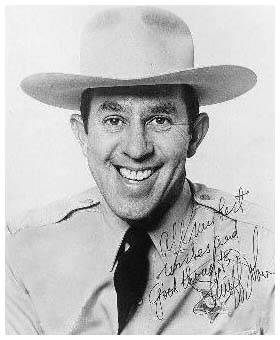
Sheriff John was a long-running children's television character who appeared on KTTV in Los Angeles from 1952 to 1970 on two separate series, Sheriff John's Lunch Brigade and Sheriff John's Cartoon Time. He was played by John Rovick.
Sheriff John, who bore some similarities to another good-natured sheriff, Andy Taylor, started each program by entering his jailhouse office singing "Laugh and be happy, and the world will laugh with you ..." before doing a routine which included the Pledge of Allegiance and a safety bulletin.
He would also show cartoons, including Crusader Rabbit and Porky Pig among others, have a visit from various farm animals and from an artist "Sketchbook Suzie," who would draw pictures requested by home viewers.
Sheriff John also encouraged his viewers to eat Maggio carrots, "the carrots with the green tops." The grower was evidently one of the show's sponsors. When we kids ate lunch with Sheriff John, we said grace:
"Heavenly Father, great and good, we thank You for our daily food. Bless us, even as we pray. Guide and keep us through this day. Amen."
The unquestioned highlight of the show was the Birthday celebration. The Sheriff would read off as many as a hundred names on the show, and then bring out a cake and sing the Birthday Party Polka, which went:
Put another candle on my birthday cake,
We're gonna bake a birthday cake.
Put another candle on my birthday cake,
I'm another year old to-day.
I'm going to have a party with my birthday cake,
C'mon and taste some birthday cake.
Put another candle on my birthday cake,
I'm another year old to-day.
We'll have some pie and sandwiches,
and chocolate ice cream too.
We'll sing and play the day away,
and one more thing I'm gonna do ...
I'll blow out the candles on my birthday cake,
And when I do, a wish I'll make!
Put another candle on my birthday cake,
I'm another year old to-day.
Engineer Bill
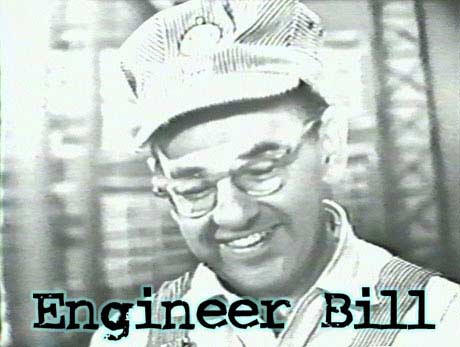
I drank a lot of milk because of this guy!
William Stulla, former Denver and Los Angeles based radio/TV broadcaster best known to kids as "Engineer Bill" is dead.
Mr. Stulla passed away at his Westlake Village, CA. home on Tuesday August 12, 2008 at the age of 97. A native of NYC, Mr. Stulla and his parents (his father was a printer) moved from NYC to Erie, Pa, Cleveland, Ohio and to Buffalo, N.Y. before settling in Denver, Colorado.
After graduating from high school in Denver, Bill Stulla read an ad posted on a trolley that was promoting classes in radio broadcasting techniques at the University Of Denver. He took the classes, graduated and eventually acquired his first radio job with KFEL in Denver; later he worked for NBC's Denver affiliate KOA as an announcer and a scriptwriter. He remained with KOA for five years before he moved to Southern California where he joined the NBC affiliate KFL in 1939.
Stulla's broadcasting career was interrupted by his service during WWII. Instead of fighting in the infantry he worked as a broadcaster for Armed Forces Radio where he broadcast news and entertainment for the troops in the Far East. Upon his return to the States, Stulla hosted a radio variety series Bill Stulla's Parlor Party on local radio and TV in L.A. until 1954 when KHJ (now known as KCAL) TV Channel 9 mentioned that they were holding auditions for a new kids series titled Ranger Ed, a forgettable rip off of KTTV 11's Lunch With Sheriff John.
Stulla's wife insisted that her husband audition for the show - he was interested but not as a copy of Mr. Rovick's lawman character. "I've got an idea for a better show. It's a railroad show," Mr. Stulla explained to the L.A. Times."I want to be an engineer and run trains and play cartoons ,because I knew that the station had bought some cartoons."
Accepting his concept the station execs at KHJ TV hired Stulla and in late 1954 The Cartoon Express With Engineer Bill went on the air as a weekday evening kids wraparound program set against the backdrop of a roundhouse. Each night Mr. Stulla's kindly, old train man would interview two kids, a boy and girl, who would send in their model toy trains to be exhibited on the program. He would also try to bring out the kids' personalities in his impromptu conversations with the sters.
Stulla would also play games with the kids in the studio, engage them in craftmaking, hobbies, train lore and interview guest performers and personalities in between the reruns of Gumby puppet films, Spunky & Tadpole, Q. T. Hush, Col. Bleep TV cartoons and Superman movie cartoons. The show even had it's own theme song "Who's that coming down the track, who's that puffing smoke so black? Who's at the throttled? It's Engineer Bill!"
Stulla was also able to instill good values in his viewers and studio audiences by having them promise to do the right thing and encourage his little train "Little Mo" to move up the hill (a model trainer was shown moving slowly up a small scale track in a pre filmed segment ala "The Little Engine That Could".
He got the kids to drink their milk via an on camera game called "Red Light/ Green Light" where the kids at home would watch "Engineer Bill" and his in studio guests drink a glass of Cow Juice, they'd drink when a superimposed image of a green signal light was seen on screen, they'd stop when a Red signal light was shown on screen.
Stulla became a popular personality with Southern California kids and he was always in demand for personal appearances and he became friendly with L.A.'s other kids TV MC's including "Sheriff John" Rovick and "Skipper Tom" Hatten.
Tom Hatten And Popeye
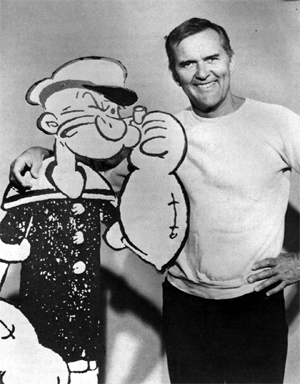
Starting out life in Jamestown, North Dakota, Tom's family moved to Idaho in his early teens. During World War two, he served in the Navy. In 1947 he attended the prestigious Pasadena School of the Theater for three years (on a GI bill) where he graduated cum laude in 1949In 1952 Tom launched his broadcasting career off the sunny shores of downtown Hollywood at KTLA studios. It was his first broadcasting job and like a lot of people in the early days of KTLA, wore many hats at the station, from commercial spokesman, staff announcer and newsman to a sailor's hat for KTLA Channel 5's afternoon kid's show, "The Popeye Show". KTLA had just acquired 300 classic Paramount Popeye cartoons and Tom Hatten began his hitch on the show. He soon became a popular and well-liked addition to our local TV family.
Most LA kids will remember that Skipper Tom Hatten'sPopeye (Pier 5 club) show was held five days a week on a set that looked like a ship. The original show aired from 1956 to 1964 and featured Skipper Tom and his Squiggle game. Squiggles were impromptu drawings that Tom drew on the show for the kids in the studio and at home. Starting with asking his young guests to squiggle something on his sketch board, he would magically create a finished picture (usually of a Popeye character). He probably was responsible for inspiring many a youngster to investigate their creative sides. Sketching and cartooning are just a few of Tom Hatten's many talents.